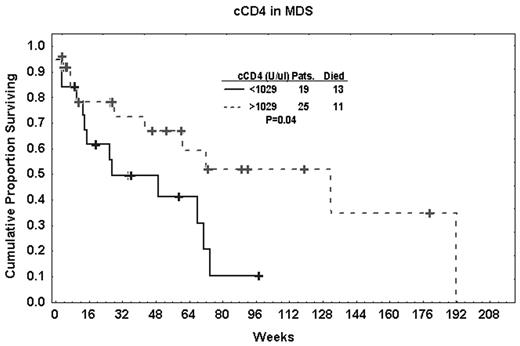Abstract
CD4 is a 55-kDa glycoprotein expressed mainly on the surface of helper/inducer T-cells and monocyte-derived cells. CD4 responds to antigen associated with MHC class II. CD8 is a disulfide-linked dimer of either an alpha- and a beta-chain or two alpha-chains (34 kDa each). CD8 is expressed on T-cytotoxic/suppressor cells and binds to antigen associated with MHC class I. Since leukemias are known to elicit an immune response we speculated that, owing to turnover of the responding T-cells, free circulating CD4 (cCD4) and CD8 (cCD8) could be detected in the plasma of patients with leukemias. We have developed a bead-based sandwich immunoassay to measure cCD4 and cCD8 in the plasma. Using this assay, we measured cCD4 and cCD8 in the plasma of 98 patients with AML and 50 patients with MDS and assessed associations with clinical behavior. Whereas cCD4 levels did not differ significantly between AML (median, 918 U/μl; range, 0–30038 U/μl) and MDS (median, 1029 U/μl; range, 0–48338 U/μl in MDS), cCD8 levels were significantly higher in AML (median, 120390 U/μl; range, 0–694820 U/μl) than in MDS (median, 105340 U/μl; range, 0–810110 U/μl) (P=0.03). The ratio of cCD4 to cCD8 was significantly higher in AML and MDS than in 51 normal controls (P <0.01). There was no correlation between cCD4 or cCD8 and clinical response or survival in AML patients. In MDS, Cox regression analysis showed that higher levels of cCD4 correlated with longer survival when considered as a continuous variable (P = 0.03) and when the median was considered as a cut-point (P = 0.04). MDS patients with high levels of cCD4 (>929 U/μl) also had longer remission duration (P = 0.01); there was no correlation between cCD8 levels and clinical behavior. These findings confirm that the immune system plays a significant role in the clinical behavior of MDS and shows that CD4 cells are more important immunomodulator in MDS.
Disclosure: No relevant conflicts of interest to declare.
Author notes
Corresponding author


This feature is available to Subscribers Only
Sign In or Create an Account Close Modal